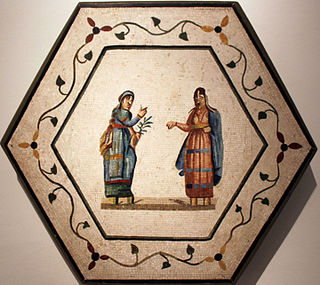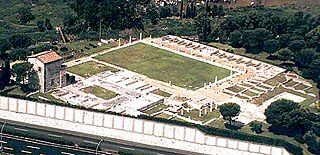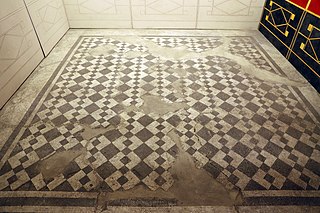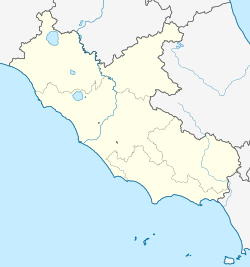
A mosaic is a pattern or image made of small regular or irregular pieces of colored stone, glass or ceramic, held in place by plaster/mortar, and covering a surface. Mosaics are often used as floor and wall decoration, and were particularly popular in the Ancient Roman world.

Lake Nemi is a small circular volcanic lake in the Alban Hills 30 km (19 mi) south of Rome in the Lazio region of Italy. It takes its name from Nemi, the largest town in the area, that overlooks it from a height.

Otricoli is a town and comune in the province of Terni, Umbria, central Italy. It is located on the Via Flaminia, near the east bank of the Tiber, some 70 km north of Rome and 20 km south of Narni.

Hispellum was an ancient town of Umbria, Italy, 6 km (3.7 mi) north of Fulginiae on the road to Perusia.

Lorium was an ancient village of ancient Etruria, Italy, on the Via Aurelia, 19 km west of Rome, near today's Castel di Guido.

Cottanello is a comune (municipality) in the Province of Rieti in the Italian region of Latium, located about 60 kilometres (37 mi) north of Rome and about 15 kilometres (9 mi) west of Rieti.

Poggio Mirteto is a comune (municipality) is situated in the Tiber Valley Central Italian region of Latium. Administratively Poggio Mirteto is in the province of Rieti and geographically this municipality is about 45 kilometres (28 mi) northeast of Rome and about 20 kilometres (12 mi) southwest of Rieti.

Santa Marinella is a comune (municipality) in the Metropolitan City of Rome in the Italian region Lazio, located about 60 kilometres (37 mi) northwest of Rome.

The Piscina Mirabilis is an Ancient Roman cistern on the Bacoli hill at the western end of the Gulf of Naples, southern Italy. It ranks as one of the largest ancient cisterns built by the ancient Romans, compared to the largest Roman reservoir, the Yerebatan Sarayi in Istanbul.

Horace's Villa is a large ancient Roman villa complex near Licenza, Italy. The identification is likely because Horace wrote several poems about the place, and the special elaborate architectural features and location of the villa correspond to the descriptions in the poetry.

Oplontis is an ancient Roman archaeological site located in the town of Torre Annunziata, south of Naples in the Campania region of southern Italy. The excavated site comprises two Roman villas, the best-known of which is Villa A, the so-called Villa Poppaea.

The Domus Romana, stylized as the Domvs Romana, is a ruined Roman-era house located on the boundary between Mdina and Rabat, Malta. It was built in the 1st century BC as an aristocratic town house (domus) within the Roman city of Melite. In the 11th century, a Muslim cemetery was established on the remains of the domus.

A Roman mosaic is a mosaic made during the Roman period, throughout the Roman Republic and later Empire. Mosaics were used in a variety of private and public buildings, on both floors and walls, though they competed with cheaper frescos for the latter. They were highly influenced by earlier and contemporary Hellenistic Greek mosaics, and often included famous figures from history and mythology, such as Alexander the Great in the Alexander Mosaic.

The House of Eirene is an ancient Roman peristyle house with lavish mosaic floors in Philippopolis, built in the middle of the 3rd century AD in the provincial capital of Thracia. It is named after the image of the Greek goddess Eirene, depicted in the central mosaic.

The mosaics of Delos are a significant body of ancient Greek mosaic art. Most of the surviving mosaics from Delos, Greece, an island in the Cyclades, date to the last half of the 2nd century BC and early 1st century BC, during the Hellenistic period and beginning of the Roman period of Greece. Hellenistic mosaics were no longer produced after roughly 69 BC, due to warfare with the Kingdom of Pontus and the subsequently abrupt decline of the island's population and position as a major trading center. Among Hellenistic Greek archaeological sites, Delos contains one of the highest concentrations of surviving mosaic artworks. Approximately half of all surviving tessellated Greek mosaics from the Hellenistic period come from Delos.

The ancient Roman Villa dei Volusii or Villa dei Volusii-Saturnini is an archaeological site located in the municipality of Fiano Romano, next to the ancient Roman town and sanctuary of Lucus Feroniae, along the route of ancient Via Tiberina.

The ancient Roman villa of Quintus Axius was a large rural villa rustica in the locality of Grotte di San Nicola, Colli sul Velino, Italy.

The imperial ancient Roman villa of Ossaia was a large luxurious villa rustica in the rural locality of modern Ossaia, 5 km south of the ancient and modern town of Cortona. It belonged at one time to the family of Augustus, namely his grandsons Gaius Caesar and Lucius Caesar.
The ancient Sanctuary of Venus at Hispellum was a grandiose theatre-temple-amphitheatre complex, today located partially in the grounds of the Villa Fidelia to the northwest of the city. It was located ouside the walls of the ancient city on a slope near the bottom of the Spello hill facing west as part of an impressive monumental layout.

The extensive luxurious Roman villa Palazzi di Casignana is located on the seashore and near the ancient road linking ancient Locri and Rhegion in today's province of Calabria, Italy. It was discovered in 1964. It reached its zenith during the late empire of the 4th c. AD, a period of turbulence elsewhere.























